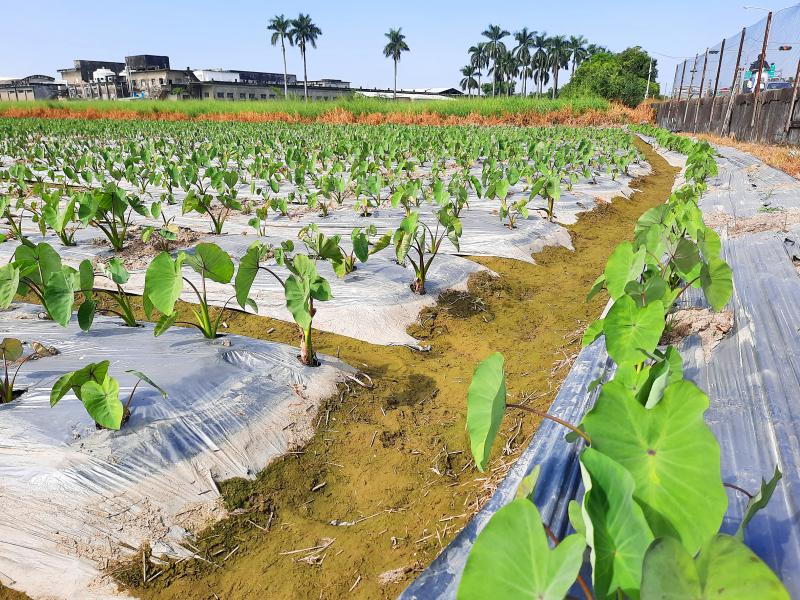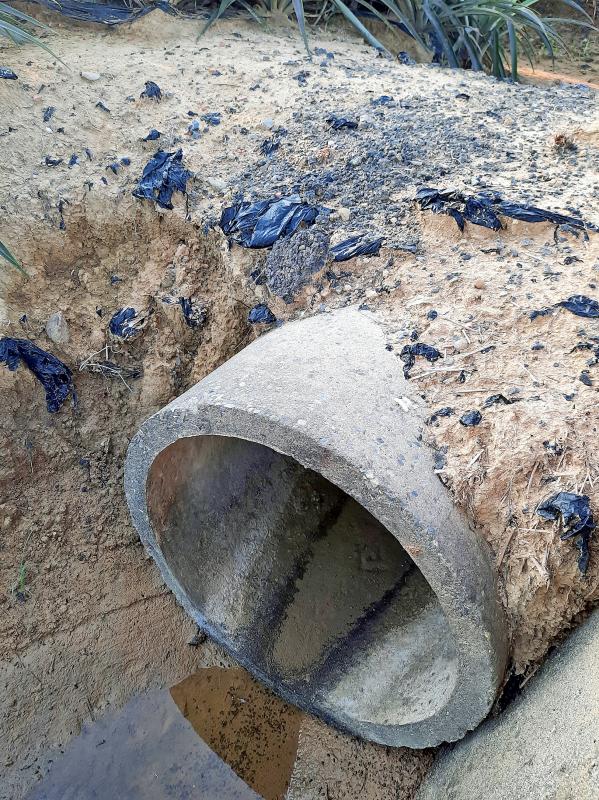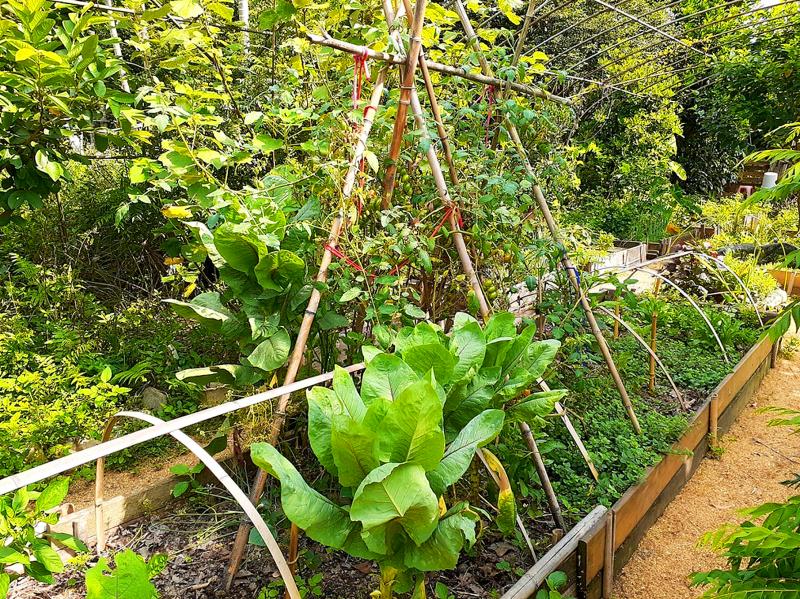In Taiwan’s rural lowlands, it’s a common sight at this time of year. Having cleared and plowed their fields, farmers intending to grow pineapples, strawberries or certain other crops, roll lengths of thin black plastic across the ground. To keep the film in place, soil is piled over the edges.
Plastic sheeting — or plastic mulch, as it’s often called — makes farmers’ lives easier by suppressing unwanted foliage that might otherwise crowd out their crops.
As an inexpensive labor-saving technique, its appeal is obvious. Taiwan’s farmers are getting old (in 2014, their mean age was 62 years), and finding hired help willing to pull weeds isn’t easy.

Photo: Steven Crook
Those who defend the use of synthetic mulch also claim it can reduce the use of insecticides. By reflecting light, the plastic repels certain pests, among them thrips (which damage fruits and legumes), spider mites (10 of Taiwan’s 74 spider-mite species are considered major pests) and whiteflies (which transmit plant viruses).
AGRICULTURAL PLASTICS
But one of its drawbacks is obvious to anyone who takes a close look at the landscape. Countless fields are strewn with shreds of black plastic. As these scraps break apart and break down, they turn into microplastics (fragments no more than 5 mm in length) and nanoplastics (particles so small they can penetrate human organs and tissues).

Photo: Steven Crook
In recent years, scientists have realized that plastics pollution isn’t limited to the bags, bottles and other visible trash that lingers by roadsides or washes up on beaches. Microplastics have been found on mountain tops, in bottles of mineral water fresh from the manufacturer, in seafood, inside fruits and vegetables grown far from industrial zones, and in human feces.
Because this is a relatively new phenomenon, scientists aren’t clear as to the effect of microplastics on human health. But it probably isn’t good.
The Environmental Protection Administration’s (EPA) Web site warns farmers that they face punishment if they discard or burn agricultural plastics, yet this law seems no more effective than others against littering. The EPA also recommends the use of alternative materials such as decomposable film (typically three times the price of conventional plastic mulch) or straw.

Photo Courtesy of Tammy Turner
Jarl Enterprise — a Kaohsiung-based manufacturer of agricultural implements that sells 400-meter-long, 1.83-meter-wide rolls of silver-black insect-proof plastic mulch for NT$1,860 — says in an e-mailed response that it can produce biodegradable films, but due to low market demand, it doesn’t.
SAFER ALTERNATIVES
Compared to plastic, using straw is less likely to lead to soil salinization. It’s also better for the spiders and insects that prey on crop pests.

Photo: Steven Crook
“Taiwan is less responsible than other countries when it comes to the use of plastic in agriculture,” says Tammy Turner, an American who’s been practicing permaculture, a holistic environmental and agricultural design system, for 15 years, and teaching it in certification courses in Taiwan, India and China for 9 years.
“Its use has already been identified as problematic by the authorities and by some people who work in food production,” Turner says.
On March 31, the Chinese-language China Times reported that Miaoli County Government’s Agriculture Department and Environmental Protection Bureau are trying to improve the recycling rate for the 250-odd tonnes of plastic mulch discarded by strawberry farmers in Dahu Township (大湖) at the end of each growing season.
When the film is mixed with soil or field stubble, recycling businesses are reluctant to process it, so the authorities have encouraged farmers to pre-clean the plastic, and offered subsidies for the purchase of specialized recycling machines.
Rather than focus on recycling, Turner favors the use of organic mulches, and a change in attitude.
“Because they grow so fast in Taiwan’s weather, among local farmers there’s zero tolerance for weeds — even though they grow in synergy, not in competition, with crops,” she says.
Taiwanese indigenous polyculture is far more weed-tolerant, she explains. Aboriginal agriculturalists regard each and every plant as having its own place in the ecosystem. By observing what others may regard as “weeds,” they can know something about the health and characteristics of the soil.
Oftentimes, those plants are sources of food or medicine.
“Indigenous farmers see everything as edible or useful, because indigenous communities have retained certain traditional knowledge. The Amis people are particularly skilled in this way,” Turner says.
Because sheeting traps heat in the topsoil, it can help kill off pathogens, the seeds of weed species and nematodes (microscopic roundworms that penetrate the roots of certain plants so they can lay their eggs inside).
Heating up the soil is hardly ever beneficial, Turner says. In fact, it often brings a set of fresh problems.
While acknowledging that the convenience of plastic mulch, a 2018 report on the News&Market Web site describes how synthetic sheeting can make crops unhealthy.
Plastic mulch prevents moisture in the soil from evaporating. This leads to a concentration of moisture under the sheets, which means that fertilizer in the soil is drawn up toward the surface. Because they can find both water and fertilizer near the surface, plants don’t establish deep roots.
The consequences of this are twofold. Being so close to the plastic mulch — which can reach noontime temperatures above 70 degrees Celsius — the roots are in greater danger of suffering heat stress. Also, if the root system is shallow, it’s more likely to be damaged if a typhoon strikes.
Planting crops, along with their companion plants, more densely is one way to reduce the number of weeds. This also supplies a secondary yield, such as aromatic flowers or herbs, Turner says.
ORGANIC MULCH
Permaculture practitioners see organic mulches as far superior to plastic mulches.
“The soil gets more organic matter and higher levels of microbiological activity that improves nutrient uptake and water retention,” Turner says.
“Soil health wasn’t much thought about until a few years ago, but now regenerative agriculture is being promoted by the Council of Agriculture,” she explains. “Once you’ve got your soil to a specific level of health, you don’t really need fertilizer. You’re simply cycling organic matter and nutrients.”
According to Turner, farmers who resort to plastic mulches “are often creating the conditions for soil erosion. Lots of chemical and labor inputs are required to support that kind of system, and it further degrades the system.”
Organic mulch can be free.
“By growing different plants in succession, a farmer could — possibly in cooperation with neighboring farmers — produce all the mulch he needs,” Turner says.
Banana trunks are a great source of mulch, because they contain so much fiber and water, Turner says. Some indigenous farming systems use pigeon peas. Grasses and tree leaves can be deployed as mulch. Turner also uses rice husks, peanut shells, crushed-up bamboo and “green manure” (plants grown and plowed into the soil to improve its quality).
Rice-straw mulch may be suitable for commercial farms where rapid growth is desired, Turner says, but she warns that if the rice was sprayed with chemicals, the straw may be tainted by residues, an issue with many agricultural byproducts.
PERMACULTURE
Turner argues that land cultivated via permaculture design concepts and regenerative agricultural practices can be more productive over time than land farmed conventionally through soil building, yield diversification and risk mitigation.
“Depending on what you’re growing, the amount of light reaching the food plants is key,” she explains. “Fast-growing trees can be the source of mulch, animal feed... that helps build soil and regenerates itself after regular harvesting, thus reducing photosynthetic competition.”
Turner adds that Taiwan is ripe for doing much better in using trees and woody perennials in its growing systems. This would result in better water retention, less runoff, better retention of topsoil, which is where the nutrients are, and improve soil biology.
Unfortunately, the current subsidy system works against such practices.
“You can’t have trees in a farm field, because that’s seen as letting your field go fallow,” Turner laments.
Yet, she says, the principal source of resistance isn’t the government: “Farmers are by nature conservative, so we need to create successful examples to win people over.”
Turner’s permaculture classes are increasingly popular with young people: “Half of them are under 25. The youngest is 16. They’re definitely willing to try a new approach, but they lack access to land.”
That could soon change. So many old farmers are leaving the scene that Turner thinks Taiwanese agriculture could be entering a decade of great opportunity. “I’m telling my students to urge their parents or grandparents to hand over their land.”
Steven Crook, the author or co-author of four books about Taiwan, has been following environmental issues since he arrived in the country in 1991. He drives a hybrid and carries his own chopsticks. The views expressed here are his own.

Seven hundred job applications. One interview. Marco Mascaro arrived in Taiwan last year with a PhD in engineering physics and years of experience at a European research center. He thought his Gold Card would guarantee him a foothold in Taiwan’s job market. “It’s marketed as if Taiwan really needs you,” the 33-year-old Italian says. “The reality is that companies here don’t really need us.” The Employment Gold Card was designed to fix Taiwan’s labor shortage by offering foreign professionals a combined resident visa and open work permit valid for three years. But for many, like Mascaro, the welcome mat ends at the door. A

Last week gave us the droll little comedy of People’s Republic of China’s (PRC) consul general in Osaka posting a threat on X in response to Japanese Prime Minister Sanae Takaichi saying to the Diet that a Chinese attack on Taiwan may be an “existential threat” to Japan. That would allow Japanese Self Defence Forces to respond militarily. The PRC representative then said that if a “filthy neck sticks itself in uninvited, we will cut it off without a moment’s hesitation. Are you prepared for that?” This was widely, and probably deliberately, construed as a threat to behead Takaichi, though it

If China attacks, will Taiwanese be willing to fight? Analysts of certain types obsess over questions like this, especially military analysts and those with an ax to grind as to whether Taiwan is worth defending, or should be cut loose to appease Beijing. Fellow columnist Michael Turton in “Notes from Central Taiwan: Willing to fight for the homeland” (Nov. 6, page 12) provides a superb analysis of this topic, how it is used and manipulated to political ends and what the underlying data shows. The problem is that most analysis is centered around polling data, which as Turton observes, “many of these

Since Cheng Li-wun (鄭麗文) was elected Chinese Nationalist Party (KMT) chair on Oct. 18, she has become a polarizing figure. Her supporters see her as a firebrand critic of the ruling Democratic Progressive Party (DPP), while others, including some in her own party, have charged that she is Chinese President Xi Jinping’s (習近平) preferred candidate and that her election was possibly supported by the Chinese Communist Party’s (CPP) unit for political warfare and international influence, the “united front.” Indeed, Xi quickly congratulated Cheng upon her election. The 55-year-old former lawmaker and ex-talk show host, who was sworn in on Nov.